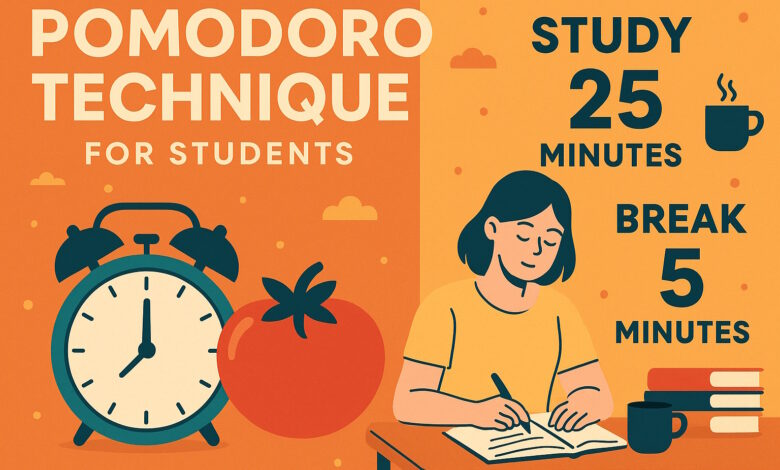Pomodoro Technique for Students – Study Smart, Not Hard

Do you ever sit down to study, only to find yourself distracted within minutes? Do your study sessions stretch on endlessly, yet you feel like you’ve learned nothing? If yes, then it’s time to try the Pomodoro Technique — a scientifically backed method that can boost your focus and productivity without burning you out.
In this article, we’ll explore what the Pomodoro Technique is, how it works, how students can benefit from it, step-by-step instructions, and real tips to make it work for you. Whether you’re preparing for NEET, JEE, UPSC, or board exams, this simple method could change how you study forever.
What is the Pomodoro Technique?
The Pomodoro Technique is a time management method developed in the late 1980s by Francesco Cirillo. The name “Pomodoro” means “tomato” in Italian and was inspired by a tomato-shaped kitchen timer he used.
The core idea is simple:
You study or work for 25 minutes (called one “Pomodoro”), then take a 5-minute break. After four Pomodoros, you take a longer break of 15–30 minutes.
This cycle helps your brain stay fresh and focused, avoiding burnout and distractions.
Why is it So Effective for Students?
Here’s why the Pomodoro Technique is especially useful for students:
- ✅ Boosts Concentration – Short study sprints keep your mind engaged.
- ✅ Fights Procrastination – It’s easier to commit to 25 minutes than a 3-hour block.
- ✅ Reduces Mental Fatigue – Frequent breaks help your brain recharge.
- ✅ Improves Time Awareness – You become conscious of how you spend time.
- ✅ Supports Revision – Perfect for breaking large topics into smaller parts.
How to Do Pomodoro – Step-by-Step
Here’s how students can implement the Pomodoro Technique:
Step 1: Choose a Task
Pick the subject or topic you want to study. Make sure it’s clear and measurable. Example: “Revise Class 12 Biology Chapter 5 – Human Physiology.”
Step 2: Set a Timer for 25 Minutes
Use a kitchen timer, phone app, or online Pomodoro timer. Don’t multitask. Focus only on that one topic.
Step 3: Study Until the Timer Rings
Study with full attention. Don’t check your phone or social media. If you remember something else to do, note it down and come back to it later.
Step 4: Take a 5-Minute Break
Relax, stretch, grab water, walk around. Let your brain reset.
Step 5: Repeat
After four Pomodoros (about 2 hours), take a 15–30 minute longer break.
Example Pomodoro Schedule for a Day
| Time Slot | Activity |
|---|---|
| 9:00 AM – 9:25 AM | Pomodoro 1 – Study Physics |
| 9:25 AM – 9:30 AM | Break |
| 9:30 AM – 9:55 AM | Pomodoro 2 – Practice Numericals |
| 9:55 AM – 10:00 AM | Break |
| 10:00 AM – 10:25 AM | Pomodoro 3 – Revise Notes |
| 10:25 AM – 10:30 AM | Break |
| 10:30 AM – 10:55 AM | Pomodoro 4 – Solve MCQs |
| 10:55 AM – 11:30 AM | Long Break (Relax, Eat, Meditate) |
Tips to Make the Pomodoro Method Work
Here are some expert-backed tips to make this method work better for students:
✅ Use a Dedicated Timer
Apps like Focus To-Do, Pomofocus, or TomatoTimer help you keep track.
✅ Remove Distractions
Put your phone on silent or airplane mode. Inform family you’re studying.
✅ Track Progress
Maintain a Pomodoro logbook to note what you studied in each session.
✅ Use Breaks Wisely
Don’t start watching long videos or scrolling social media. Use breaks to rest, move, or breathe.
✅ Customize Time if Needed
Some students prefer 50-minute study sessions with 10-minute breaks. Find what suits your rhythm.
Real-Life Success Story
Pooja Sharma, a NEET aspirant from Jaipur, used the Pomodoro Technique during her 12th boards. She divided her syllabus into 25-minute tasks daily and used breaks to avoid burnout.
“I used to sit for hours without focus. But once I started using Pomodoro, my revision became faster and I remembered things better. Even 6 hours of study felt productive!”
Best Pomodoro Apps for Indian Students
Here are some free and paid tools to help you get started:
| App Name | Platform | Features |
|---|---|---|
| Focus To-Do | Android, iOS, PC | Timer, Task List, Reminders |
| Forest | Android, iOS | Grow virtual trees while you study |
| Pomofocus.io | Web | Clean and simple online timer |
| Marinara Timer | Web | Customizable Pomodoro cycles |
| Brain Focus | Android | Advanced reports & timer settings |
Is Pomodoro for Everyone?
While Pomodoro works wonders for most students, it may not suit everyone. Some topics need longer focus time (e.g., solving tough math problems). In that case:
- Try using longer Pomodoros (40–50 mins)
- Use Pomodoro for theory subjects like History or Biology
- Use it during revision days or when your energy is low
Benefits of Pomodoro for Exam Preparation
| Benefits | Impact on Study |
|---|---|
| Increased Focus | You absorb more in less time |
| Reduced Stress | Frequent breaks reduce tension |
| Better Time Management | Helps cover full syllabus on time |
| Improved Memory | Regular short bursts aid retention |
| Enhanced Motivation | Helps build study momentum daily |
Common Mistakes to Avoid
- ❌ Checking phone during break time and extending it
- ❌ Skipping long breaks after 4 Pomodoros
- ❌ Multitasking during Pomodoro time
- ❌ Not planning what to study before starting
How to Stick With It Daily
Make Pomodoro a habit by:
- Keeping a checklist of tasks
- Using rewards (e.g., one episode of your favorite show after 8 Pomodoros)
- Studying with friends using shared timers
- Creating a calm study environment
Pomodoro vs Traditional Studying
| Feature | Traditional Study | Pomodoro Technique |
|---|---|---|
| Study Duration | Long & Exhausting | Short & Refreshing |
| Breaks | Rare | Regular |
| Focus | Decreases Over Time | Maintained Easily |
| Planning | Not Structured | Pre-planned |
| Burnout | High Risk | Low Risk |
Conclusion
The Pomodoro Technique is a life-changing method for students who want to study smarter, not harder. It’s easy to adopt, requires no investment, and works for any syllabus — whether it’s CBSE, ICSE, NEET, or UPSC.
If you’ve been struggling to concentrate, feeling overwhelmed by a heavy syllabus, or wasting time despite long study hours — give Pomodoro a try. It’s one small change that can make a huge difference in your academic journey.
FAQs – Pomodoro Technique for Students
Q1. Is the Pomodoro Technique good for long study sessions?
Yes! You can repeat Pomodoro cycles throughout the day. The regular breaks prevent fatigue.
Q2. Can I change the 25-minute timer to 40 minutes?
Absolutely. The idea is flexible. Many students use 50/10 or 45/15 depending on the subject.
Q3. Will I get distracted during breaks?
It depends on how you use your break. Avoid opening Instagram or YouTube. Instead, stretch, drink water, or meditate.
Q4. Can I use Pomodoro for subjects like Maths or Chemistry?
Yes. Use it to solve numericals, revise formulas, or attempt mock tests.
Q5. What if I get interrupted during Pomodoro time?
If it’s urgent, pause the timer and resume later. But try to avoid interruptions as much as possible.



